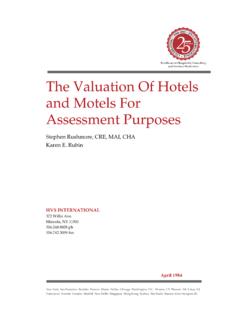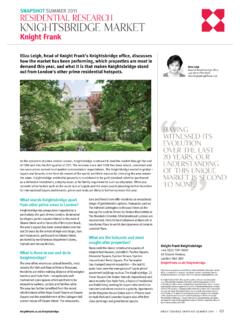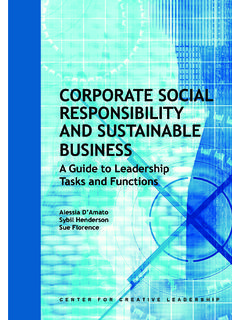Transcription of SNAPSHOT PRAGUE, CZECH REPUBLIC - HVS | Home
1 HVS London Office| 7 10 Chandos Street, Cavendish Square, London W1G 9DQ, MARKET SNAPSHOT prague , CZECH REPUBLIC MAY 2012 | PRICE 75 Lucy Payne Market Intelligence Analyst MARKET SNAPSHOT prague , CZECH REPUBLIC | PAGE 2 This market SNAPSHOT is part of a series of articles that HVS produces on key hotel sectors across Europe. In writing these articles we combine the expertise of HVS with STR Global data for each market. Our analysis is based on data for a sample of 74 mainly branded properties as provided by STR Global. Highlights Following a dip in economic growth in 2009, the CZECH REPUBLIC s economy showed modest signs of recovery in 2010 with GDP growth of According to the Economic Intelligence Unit s April 2012 forecast, GDP is expected to have grown by in 2011 and will continue to grow into 2012 and 2013 by and , respectively; prague , the capital of the CZECH REPUBLIC , attracted more than million visitor arrivals and million bednights in 2011, representing an 8% (visitor arrivals) and 9% (bednights) increase on 2010.
2 The majority of these were generated from international visitors, which accounted for 86% of total arrivals and 90% of total bednights; The main international source markets for prague in terms of arrivals are Germany (15% of international arrivals in 2011), Russia (9%) and the UK (6%); prague Ruzyn International Airport has recorded significant increases in passenger numbers over the past ten years with a compound annual growth rate of ; the majority of demand is generated by international arrivals; The meeting, incentive, conference and exhibition (MICE) sector was impacted by the economic crisis, with the number of meetings and events held in the city declining in 2010. Figures for 2011 are unavailable at present, but as tourism has increased it is likely that the number of meetings and events has followed suit; The hotel performance figures for the 12 months to February 2012 show prague s hotel market is recovering from the economic crisis, with occupancy and average rate both growing.
3 As a result, revenue per available rooms (RevPAR) saw growth in both euro and CZECH koruna terms; growth was largely led by increases in occupancy; prague has seen a number of hotels enter the market over recent years, leading to a large growth in hotel rooms. Development has now slowed, giving the city a chance to absorb the new additions to supply; prague s hotel investment market has been significantly impacted by the economic crisis and has remained generally unremarkable over the past few years. Only two transactions have taken place since 2010: the InterContinental prague and the ibis Praha Karlin; As per the annual HVS hotel Valuation Index (HVI), prague ended 2011 with values of around 166,000 or CZK4,100,000 per room for an internationally branded, four star, city centre property representing increases of 4% and 1% in euro and CZECH koruna respectively.
4 hotel Demand Patterns prague Ruzyn International Airport, the largest airport in the CZECH REPUBLIC , was impacted by the economic crisis with arrivals declining by in 2009 and in 2010. In 2011, the airport carried almost million passengers, a increase on the previous year and a sign that tourism is returning to prague . The airport has shown significant growth over the past ten years, with arrivals growing from 6 million in 2001 to almost million in 2011, a compound annual growth of MARKET SNAPSHOT prague , CZECH REPUBLIC | PAGE 3 CHART 2: hotel PERFORMANCE IN prague 2010 12 (EURO) 1,0001,5002,00055606570 Average Rate and RevPAR (CZK)Occupancy (%)Source: STR GlobalAverage RateOccupancyRevPAR CHART 1: hotel PERFORMANCE IN prague 2010 12 ( CZECH KORUNA) 40%50%60%70%80%90%00%204060800020112mont hs to February 201012 months Februar 201112months to February 2012 Average Rate and RevPAR( )Source: STR GlAverageRevPAR Occupa40%50%60%70%1,0001,2501,5001,7502, 0002010201112 months to February 201012 months to February 201112 months to February 2012 OccupancyAverage Rate and RevPAR (CZK)Source.
5 STR GlobalAverage Rate (CZK)RevPAR (CZK)Occupancy Visitor arrivals have also increased steadily over the last ten years, with compound annual growth rates of (international) and (domestic). Visitor arrivals were impacted as the economic crisis took hold in 2009, with international arrivals declining by 6% and domestic arrivals remaining static. Since then, as conditions improved, both international and domestic arrivals have witnessed growth (at 8% and 12% respectively), and in 2011 total visitor arrivals peaked at million. Visitor arrivals are dominated by international demand, which accounted for 86% of total arrivals in 2011. More than 22% of total arrivals travelled with a budget airline, such as easyJet and WizzAir. Bednights have also witnessed growth, driven by international demand, which accounts for 90%. Total bednights declined in 2008 and 2009 as a result of the economic crisis, before showing growth of 8% in 2010 and a further 9% in 2011.
6 International bednights achieved 5% compound annual growth over the last ten years, while domestic bednights grew at a slower rate of over the same period. The main international source markets for prague in terms of arrivals are Germany, Russia and the UK. In 2011, Germany accounted for 15% of total international arrivals in prague while Russia and the UK accounted for 9% and 6%, respectively. Arrivals from the majority of markets showed growth in 2011 compared to the previous year, with the exception of the UK where arrivals declined by 12% as economic conditions remain challenging. Other important international markets include italy , the USA, France and Spain. The MICE (meetings, incentives, conferences and exhibitions) segment has been significantly impacted by the economic crisis, with the number of events hosted at the prague Congress Centre declining by 12% in 2010.
7 In addition, according to the International Congress and Convention Association (ICCA), prague hosted 85 international meetings in 2010 compared to 96 the previous year. Figures for 2011 are unavailable but, as tourism continues to grow, the MICE market is expected to pick up. hotel Performance The analysis in this market SNAPSHOT is based on a sample of 74 hotels in prague . Charts 1 and 2 show prague s hotel market performance in both CZECH koruna and euro. In 2010, room occupancy grew by a significant as the market began to recover from the depth of the economic crisis and the significant falls in occupancy this caused. Despite this, hoteliers were unable to increase average rate, which declined by 9% to CZK1,778 in the same period, leading to a decline in RevPAR, in CZECH koruna terms. This was a result of increased supply in the market and hoteliers reducing rates to help increase occupancy.
8 The growth in occupancy continued into 2011 with further growth of witnessed; in contrast to 2010 this was accompanied by a marginal increase of in average rate, leading to an overall increase in RevPAR of 8%. MARKET SNAPSHOT prague , CZECH REPUBLIC | PAGE 4 CHART 4: TWELVE MONTH MOVING AVERAGE OCCUPANCY, AVERAGE RATE AND REVPAR JANUARY 2010 TO FEBRUARY 2012 1,0001,5002,00055606570 Average Rate and RevPAR (CZK)Occupancy (%)Source: STR GlobalAverage RateOccupancyRevPAR CHART 3:EXCHANGE RATE FLUCTUATION, JANUARY 2010 TO MARCH 2012 ( :CZK)24252627 Exchange rate :CZKS ource: OANDAThe figures for the rolling 12 months to February paint a similar picture, with occupancy growing a significant in 2010/11 and a further in 2011/12. In CZECH koruna terms, average rate fell in the 12 months to February 2011, before showing limited growth of in 2011/12, illustrating that hoteliers are still struggling to grow average rate, despite the significant increases in occupancy.
9 In terms of RevPAR, 2010/11 showed limited growth but 2011/12 showed a noteworthy increase, fuelled by the large increases in occupancy and the static average rate. In euro terms, the decline in average rate was not as strong owing to currency fluctuations (see Chart 3). In 2010, average rate declined just , leading to a increase in RevPAR, and in 2011 average rate grew 3%, leading to a significant increase in RevPAR. The figures for 12 months to February show a decline in average rate for 2010/11 of , not as significant as in CZECH koruna terms, leading to a larger increase in RevPAR of Figures for 2011/12 show growth of in average rate and in RevPAR. Chart 4 shows the monthly moving annual average of hotel occupancy, average rate and RevPAR in CZECH kurona from January 2010 to February 2012. In terms of average rate and RevPAR, Chart 4 shows a relatively flat performance, but it is interesting to see the significant growth in occupancy over the same period.
10 Average rate struggled to grow owing to the strong competition in the market, as a number of hotels have opened in recent years. Despite this, as long as occupancy continues to grow hoteliers should be able to slowly increase average rate, leading to continued increases in RevPAR. Over the same peroid room nights have continued to increase, on average growing per month. MARKET SNAPSHOT prague , CZECH REPUBLIC | PAGE 5 CHART 5: SEASONALITY prague MONTHLY OCCUPANCY 2010, 2011 AND YEAR TO FEBRUARY 2012 30%40%50%60%70%80%90%Source: STR Global201020112012 CHART 6: hotel SUPPLY IN prague Five Star37 Hotels9%Four Star168 Hotels42%Three Star184 Hotels46% Other 12 Hotels3%Source: CZECH Statistical Office Seasonality Chart 5 shows the seasonality for the hotel market in prague for 2010, 2011 and year to February 2012. It is evident that the hotel market is recovering; 2011 occupancy levels exceeded those reached in 2010 and this positive trend is clearly continuing into 2012 as January and February were reportedly exceptional months.















